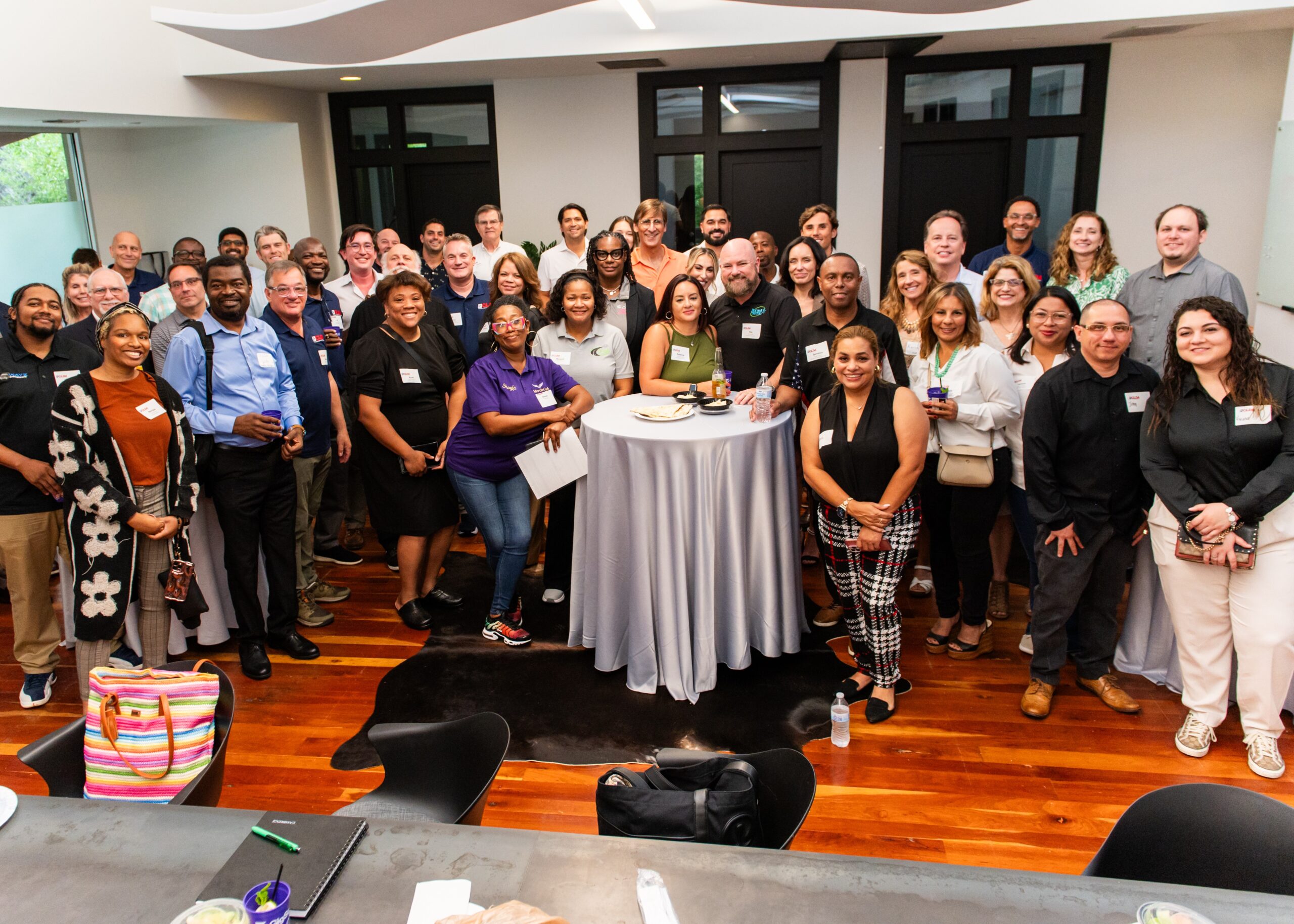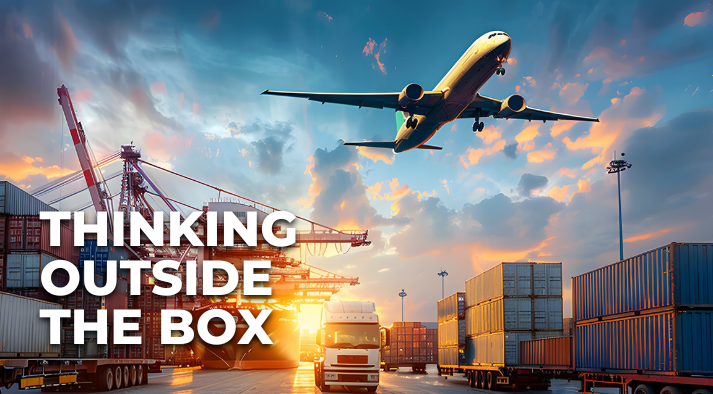











CLDA Members are encouraged to share news about their company. CLDA may share on social media, in newsletters or the Customized Logistics & Delivery Magazine.

Ready to share your news with CLDA or the industry media? Learn from these tips and tricks on how to get noticed.


This year’s holiday peak delivery season will start earlier, putting more pressure on last-mile providers than ever before. That was the prediction of CLDA Board Member, Ruth Correa. This will be her 17th holiday season in the logistics space, and she expects this to be one to remember.
Correa founded two last-mile providers, Tempo Couriers in 2008 and Cheetah Final Mile LLC in 2022. She is the CEO of Cheetah Final Mile, a transportation services company operating in Missouri and Tempo Courier in South Florida. The company focuses on same-day logistics, warehousing and outsourced transportation services. “Thinking Outside the Box” asked her for her thoughts on the upcoming holiday peak delivery season.
Earlier Start to the Holiday Peak Delivery Season
“Because of tariffs, a lot of retailers frontloaded what they bought in before the tariffs took effect,” Correa points out. “I think that will affect when the sale of those items begins this year. Even though the calendar suggests it should be a shorter holiday season, I don’t think that will hold true. I predict retailers will start holiday sales a lot earlier than in the past.”
For carriers, that means they’ll need to prepare for the peak holiday season earlier than ever before. “Everything is going to happen earlier,” she says. “We carriers are going to have to be flexible on the start of the peak season,” she says. “That means, right now, we should be looking at past data to help us optimize routes and reach more points in less time.”
Preparing Now
Correa advises couriers to take immediate action to prepare for peak season. “This is the calm before the storm,” she says. “At our company, we’re doing a lot of cleanup. We’re ensuring that all returns are taken care of. We’re freeing up floor space in our warehouses. We’re also cleaning up our equipment and replacing any that can’t do the job we need.”
On the people side of things, Correa suggests using this time to onboard new drivers. “You want to make sure you have enough drivers ready for the season ahead of time,” she advises. “They need to be onboarded correctly now so that when the time comes, you have a good pool to pick from.”
She also suggests taking a good, hard look at ways to improve efficiencies through technology. “If you’re going to bring in new technologies to improve your processes, now’s the time to start and to get your team trained to make the most of it when peak arrives, whenever it does,” she says.
She points out that while communication is always key, it becomes even more critical during the holiday season. “People have heightened expectations during the holidays because they need to know their items will arrive before Christmas Day,” she points out. “So now is the time to make sure that your processes and your technology are running correctly before that moment arrives. Whether it’s your customer, the shipper, or their customer, the consumer—everyone wants to see where their packages are and where they are along the way. That’s where technology comes in. If you have the right technology in place, everybody has visibility. That’s going to lessen the number of people you need in the office and the number of emails and phone calls you will need to respond to.”
Reach Out to Shippers
Correa expects to reach out to her regular customers starting in October to gather their estimates of what they expect from her company during the peak season. It’s something she does every year, but this year she’ll be doing it earlier. “At the beginning of October, we will be reaching out and seeing what kind of pipeline to expect from our customers,” she says.
Words of Advice
Correa offers these words of wisdom to help last-mile providers weather Holidays 2025:
1) Sleep now because you won’t be sleeping later.
2) Preparedness is key. You cannot be too prepared. Have more than you need.
3) Make sure your technology is up to speed; that everybody knows how to use it, and knows how to make the most of it.
4) Automate as much as you can.
5) Understand route optimization.
6) Add enough independent contractors to your pool now. Ensure that they’re onboarded and that you have all the necessary paperwork. Test them on routes before peak starts, so it’s not their first time during peak.
7) Have the right equipment in place to meet the need and flex when needed.
8) Train your in-house team to meet your customers’ expectations.
Correa sums it up this way: “It’s going to be interesting to see what the consumer does this holiday season. Will the tariffs raise prices enough to curtail sales? Will retailers start offering deals earlier than usual? I know the calendar says the season is supposed to be shorter, but I’m expecting it to start earlier. So what will that mean? Whatever happens, my biggest advice for carriers is to be ready to be flexible. That’s always been the strength of those in this part of the supply chain. I expect this year to be a real test of that resilience.”

What are the insurance issues impacting those in the final mile? And how can carriers manage risk?
“Thinking Outside the Box” recently interviewed Bryan Paulozzi, Vice President, Risk Strategies, part of the Brown & Brown team, to get his take on the industry today and tomorrow. Bryan and his team at Risk Strategies have been involved in risk management and insurance for those in the supply chain for over two decades.
What are some of the unique risks those in the final-mile are facing?
A lot of it is related to their use of 1099s. There are some unique risks when it comes to this sector’s use of subcontractors. These drivers are using their own vehicles to do deliveries. That’s a challenge because insurance company underwriters do not easily understand this model.
Things become even more challenging when carriers use a combination of employee and 1099 drivers. They have a fleet of vehicles that presents its own risk profile. Those hybrid risks really become challenging when it comes to insurance. Suppose we have a courier company with 20 box trucks and vans on the road, and they have 1099 drivers operating under the same authority. In that case, few insurance carriers understand and are willing to cover them.
Traditional insurance players like Allstate or Travelers don’t want to underwrite these types of risks. So when we’re working with companies like those involved with the CLDA, we often have to go into the specialty market to find coverage.
We’ve heard a lot about the changes in the marketplace, especially with the growth of e-commerce and rising consumer expectations. How have those expectations had an impact on the insurance and the risk management end of things?
Ever since COVID, the visibility of the services of those in the last-mile industry has put a spotlight on this sector of the supply chain. They are now on the radar for insurance carriers. Insurance underwriters have become more aware and attuned to it. And they are pulling back. They don’t want to deal with the unique risks in this sector. That’s tightening the underwriting market from that capacity.
In addition, if you look at how the model’s been built, using 1099 drivers who use their own cars or vans, and pickup trucks, that’s a problem. They have been using their personal auto insurance. Uber and Lyft have really shone a light on people who moonlight with their vehicles to deliver passengers and packages. We refer to that as the “uberization” of the industry. That’s not what personal auto insurance was intended to cover. If these drivers cause an auto accident, it’s questionable whether their personal auto insurance will respond to the claim. When that happens, claimants are looking to the dispatching courier company for restitution, sometimes even bypassing the 1099 driver altogether.
Furthermore, personal auto insurance carriers have gotten wiser when it comes to claims. One of the first questions they ask is “Were you making a delivery when you had this accident?” More and more, these claims are making their way up to the courier company. This is creating one of the biggest challenges facing this industry in terms of non-asset exposure is finding non-owned and hired auto insurance or contingent auto liability that insures their risk at an acceptable price for the courier company.
How about the impact of technology? How has that affected insurance and risk management for last-mile providers?
Technology is good when utilized appropriately. Often, companies have telematics, dash cams, or face cameras. These are excellent when it comes to creating a proper risk management structure for a company’s driver network. When they use the data they collect appropriately and follow through on what it tells them, these can be great tools. They help companies make sure the drivers they use are doing their jobs safely. And when this technology pinpoints a problem, smart companies work with the drivers to correct any issues.
On the other hand, those who have the technology but fail to utilize the data could face issues when a claim is made. If the technology shows unsafe behavior and a claimant’s attorney gets hold of it, that could be a problem.
What is the biggest misconception last-mile companies have about risk management?
Their most significant area of exposure is the use of independent contract drivers. Due to the sensitivity surrounding the IC model, many believe they cannot impose constraints on their drivers’ behavior regarding safety. However, just because they’re 1099s, it doesn’t mean there can’t be some form of enforcement when drivers engage in unsafe behavior. If companies notice that a 1099 is underperforming, based on the tracking mechanisms they have in place, they should take action. And if the driver continues the behavior, it’s the carrier’s prerogative as a business owner to say, “I’m no longer going to give you my work.” They have the right to choose who they work with, and they certainly want to contract with good performers.
The other misconception is around work injury coverage. That’s often something that’s overlooked for 1099 drivers. I can’t tell you how many times we’ll hear from customers that it’s not their problem if a driver gets hurt on the job. “Work injury is something they handle on their own; they are not our employees,” they tell us. But that’s not necessarily true, because anyone can sue anyone for anything. And if that 1099 does get hurt while hauling a load for you, he has the potential to try to sue you for workers’ comp as an employee. Often, this gets overlooked because courier companies think, “I only worry about my W-2s and I’ve got a workers’ comp policy to cover them.” However, there have been instances where 1099s have pursued the carrier company’s workers’ comp coverage, which can become a significant issue.
What can a carrier do to control risk?
When you talk about risk management, the most crucial thing is driver hiring practices. You’ve got to have the appropriate driver hiring practices in place.
You have a driver grading system. You have to follow through on that. I suggest you pull these reports more frequently than in prior years. That’s the first part of having a process in place to put good drivers on the road.
The next part is tackling the whole concept of the use of personal auto insurance. Understand that when you’re using 1099s who are relying on their personal auto insurance, your company is bringing yourself one step closer to the fire in the event of a loss. There’s a commercial insurance product that’s been around for 20 years that can help here. It’s called While Under Dispatch auto insurance. It provides an additional layer of coverage. Basically, it’s commercial auto insurance for 1099 drivers, covering them while they’re on dispatch. Once the driver accepts work from the company, they are covered by dispatch insurance in the event of an auto accident. I believe couriers will often find themselves in situations where this is necessary at the driver level to help create insurability for them at the corporate level. Many hired/non-owned auto insurers who are willing to underwrite courier companies are growing less fond of the whole personal auto exposure. I think over the next 12 to 24 months, we’re going to see more use of this kind of coverage. I’d advise all courier companies to start looking at this because I can foresee a time when the carriers will require something like this to secure commercial coverage of the operation.
It sounds like the environment keeps changing. How does a carrier make sure they are keeping up with those changes?
You need to work with an insurance agent who’s experienced in this arena. Last-mile carriers are unique. There are only a handful of insurance brokers in the country who know how to handle these operations.
You want to work with an agent who will be your advocate. At Risk Strategies, we’ve been specializing in this industry for the last 20+ years. It’s all we do. So we know the questions these business people have. We know how to help them wade through a 30-page application to help them further understand their business needs. No one operation is the same. So, as brokers, we need to ask a lot of questions. We know when to push for more information. We understand how to deal with the unique issues around 1099 drivers. We understand the idiosyncrasies of also having a fleet of your own vehicles. Or what kind of work injury coverage you should have. These are unique things that pose their own type of exposure. If you’re not working with someone who can have an informed conversation with the underwriter at the insurance company, it could become a problem when the coverage is needed.
The dialogue you have with a broker is the key. If you find yourself in a situation where you’re not getting those kinds of questions from your broker, you should ask yourself why. You need to interview the broker on these issues, not just about getting you the best price. What you perceive as a “better price” may, in reality, mean you’re buying less coverage. So make sure you work with a broker who can explain those trade-offs.
What I’m hearing you say is that the courier should look for a long-term relationship with the broker; one that’s more of an advisory one than a vendor one.
Yes. The best customers I have are the ones that are the most engaged. We have customers who bring us RFPs for new business, allowing us to review the risks with them before they consider taking the business. They say, “We’re thinking about getting into this line of work. What does that mean, exposure-wise, for us? There’s a trusted relationship that goes deeper than just providing them with a certificate of insurance.
When we have that type of relationship with a carrier, the pricing issue starts to dissolve. That doesn’t mean we’re not price-conscious. We have to be. But it means that ultimately we’re a member of their team. Last-mile providers need a trusted advisor, much like they would have an attorney and a tax accountant.
Given how long you’ve been involved in the industry, what are you projecting for these couriers looking forward to? What’s the environment going to be like? How are things going to change in the next three to five years?
What we’re going to see is more of a push towards a different model. The issue surrounding the use of 1099s and personal auto insurance coverage is going to come to a head. I expect those 1099s will have to carry commercial auto insurance or while under dispatch auto. As a result, courier companies could be seen less as licensed motor carriers and more like freight brokers. And, if they’re seen as having a broker carrier relationship with their 1099s, that could also help with the whole misclassification issue.
Another issue that I expect to gain prominence is the growing trend on the cyber front. This has really taken off since COVID. Because the supply chain network is so transactional, it’s been targeted by cyber criminals more than ever before. Hackers are effectively infiltrating delivery companies’ systems. They are intercepting emails. They’re redirecting ACH funds for payment to different bank accounts. They’re showing up at terminals and directing freight to a specific part of the parking lot where there’s no surveillance. And they’re having their guys loaded up with unmarked vehicles. This type of stuff is happening because the demand on the supply chain is so high. The transactional nature of this business is so fast.
We’re seeing way more cargo theft. It’s higher than it’s ever been before. So, I think that ultimately, the courier company will need to do more to protect themselves from these exposures. I think you’ll see cargo underwriters mandating warranties and implementing safety mechanisms when it comes to offering cargo insurance protecting against these issues.
Clearly, this is a complex issue. I know you’ll be doing a CLDA webinar on Sept. 10. Tell us about that.
The webinar will focus on the challenging environment we face in the insurance sector, discussing a myriad of coverage issues unique to this space while educating attendees on what to look for when shopping for their coverage. We will discuss ways to select a broker and outline some of the key questions to consider. It’s important because ultimately, if people don’t understand what they’re buying, they’ll potentially have gaps when there’s a loss.
If people have questions about this topic, how can they get in touch with you?
They can reach me directly at 440-260-1058, or via email at bpaulozzi@risk-strategies.com.

Thinking Outside the Box recently had the opportunity to get up close and personal with a shipper and their carrier to get answers to these questions. Last-mile provider Harold Boyett is the President and CEO of Blue Streak Couriers. His long-time customer, Mark Meier, is a supply chain executive in the medical industry.
Here is part of their conversation:
QUESTION: How have customer expectations changed over the years?
Meier: Our customers expect the right products to be in their hands at the right time. Their main concerns are that we are fulfilling at the speed they want with the right products. Because we operate in the healthcare space, there’s no room for error. They expect the product to arrive in good shape. That’s essentially our three-legged stool: quality, on time, and reasonable cost.
Boyett: From our point of view as carriers, the thing that’s changed the most is all about information – the information about a shipment, whether it’s a package, a pallet or an envelope. Information today is equally as important, if not more important, than the shipment itself. It’s all about knowing that it’s coming, what is coming, and, most importantly, when it’s coming. It ties in with some of the things Mark said. It’s all about the right product in the right place, at the right time.
Customers today have precise, time-definite expectations. They want to know if the delivery will arrive on Tuesday between 8 and 4, as that’s the most critical information. They’d rather know that it’s coming Tuesday between 8 and 4, with a lower cost, than to pay more to have it expedited to arrive Monday morning. If they know it’s going to be there within a specified time window, they can plan accordingly.
QUESTION: Have those expectations changed since COVID?
Meier: Yes. COVID forced customers into new patterns of behavior. They now expect that almost everything can be delivered to them. It happened with deliveries to people’s homes, and it’s played out for our customers and their businesses. Our customers are small businesses. They are healthcare offices, and they don’t keep a lot of inventory on hand. So they rely on their suppliers to have everything as readily available as possible. That’s the new normal. Everyone expects to be able to get what they need when they need it.
Boyett: There’s no question that COVID has and will continue to have an impact on customer expectations. During the pandemic, numerous packages were flowing, and seemingly everything was delayed. It didn’t matter who the carrier was, what you were ordering, or where you were ordering it. I think that’s where the emphasis on knowing when it would arrive came from. Customers saw this as more important than the actual speed of delivery.
Mark: I agree with the points Harold shared. Our customers value stable deliveries, allowing them to plan accordingly. For example, if they’re accustomed to receiving delivery within a time-definite window, on the same day, week after week, that’s what they expect. Therefore, we need to collaborate with the last-mile carrier to ensure that we meet the expectations of those customers. Setting up a stable pattern is a very important aspect of our distribution.
QUESTION: What about returns? Have customer expectations changed over the years on this issue?
Boyett: I think from a business-to-consumer perspective, my understanding is that because people are so used to ordering things–things they can’t touch or feel–that they are doing things differently. You see customers ordering three different sizes, knowing they can return the ones that don’t fit.
And today, with the omnichannel mindset of shopping, that exact scenario applies when it comes to returns. You can drop it off at the store where it was purchased or at another designated location. You can drop it at the Post Office or the UPS store. You can arrange for it to be picked up from your house. All those are things that didn’t exist five years ago.
Meier: Since our customers are healthcare providers, returns in our world are handled differently. Our customers aren’t ordering things they are unfamiliar with. So, returns usually happen because the need has shifted. These products have high intrinsic value, so returning them properly is crucial. In our case, the speed at which a return is completed isn’t as critical to the customer. If it happens within a reasonable number of business days, it’s fine as long as the return is credited promptly.
Boyett: On the other end of the spectrum, today’s consumers want almost instantaneous credit for their returns. In the B2C world, as soon as a consumer drops it off at the UPS store and when that barcode is scanned, customers expect retailers to issue a credit almost immediately.
QUESTION: As customer expectations continue to rise, how can last-mile providers face the challenge of meeting these demands while controlling costs and maintaining service quality?
Boyett: You have to leverage technology. You need to leverage technology to streamline processes, reduce costs, and build efficient workflows. The data that accompanies the packages, specifically the exceptions, is everything. You need to have technology in place that helps you manage exceptions, allowing you to identify them quickly and communicate them to the customer promptly. The best-case scenario is that they realize it before it happens.
What that means is that the customer understands you’re being as transparent as possible. It’s our job to help our customers serve their customers best. Therefore, if a carrier is aware of a problem that will cause the package to be delayed, they must notify the shipper, who can then inform their customer. It’s all about having and making the most of information as it happens. So, it’s really the information that’s the game changer. How you handle that information makes all the difference in the world to the customer who is relying upon your service.
QUESTION: Harold talks about harnessing the power of information. How important is that information in terms of the shipment’s visibility?
Meier: That’s a critical factor. It speaks directly to our credibility as a supplier. For us, credibility is carried out by the last mile, which is facilitated by the parcel carrier. I couldn’t agree more with what Harold said. It’s all about knowing where that shipment is and what’s going to happen next. Imagine a scenario where an office manager is searching for something the doctors need but can’t find answers about where it is. The worst-case scenario is when they can’t find answers. On the other end of the spectrum, if they know about an exception before they discover it, that’s a better situation. Therefore, we must trust that the information received from the carrier aligns with our real-life experience. We have to be able to trust that technology.
We know that, in the real world, traffic, outages, and weather happen. So, whatever disruption occurs, if the carrier lets us know they are addressing it appropriately, we can inform our customer. If the carrier’s data is communicated quickly, there’s less friction in a shipper’s relationship with their customer. That builds confidence, ultimately leading to increased customer loyalty.
QUESTION: We’ve discussed technology extensively, but is the human touch still important?
Meier: It is. But it all depends on the customer. When there’s an issue, some may want to talk to somebody to hear about your plan to fix it. Having a CSR with information at their fingertips who can do that well is very important.
In other situations, customers may want to get what they need with just two clicks on a website. They want to be able to see the information they need, in the way that they want to consume it, when they need it. One of the things we do when we have an exception is to point them to a self-service source. We do so not because we don’t want to talk to them face-to-face, but because it’s available to them in the moment.
QUESTIONS: Let’s end by having each of you talk about where you see customer expectations going in the next few years.
Boyett: The technology is the main thing. Technology is happening. Artificial intelligence is poised to become a significant presence in our field. The use of autonomous vehicles and robotics is expected to become increasingly important in the near future.
Meier: I’d add a couple of things there. One is that we just discussed technology and people’s comfort level with it. That was accelerated over the past couple of years. Some of those new opportunities, delivery methods, and increased information availability are being consumed much more widely than they have in the past.
We discussed the need for information to match the speed of product development. Harold mentioned something earlier about the importance of being able to tell a customer about an exception before they discover it. That will become the norm. And that bolsters customer loyalty.
Today, most of our customers are not checking websites. They’re not watching for tracking. They’re expecting it to be either Tuesday afternoon or Thursday afternoon, because that’s how it happened last time. They expect it to be fulfilled in the same way.
In other words, if you can obtain that information before they notice the package hasn’t arrived, that’s not exactly customer delight, but it’s better than the alternative. With today’s technology, that’s happening. Tomorrow’s tech will make it happen even faster. And with that, we’ll be able to continue to improve customer satisfaction and loyalty.

Drivers and dispatchers juggle tight delivery windows, unpredictable traffic, demanding customers, and complex special instructions. Unlike warehouse workers or line-haul drivers who might stay behind the scenes, final-mile professionals are face-to-face with customers every day.
And while most interactions are routine, friendly, and professional – some aren’t.
In the world of final-mile delivery and customized logistics, you’re not just moving packages. You’re delivering promises.
The customer on the doorstep isn’t thinking about your carefully optimized route, your tight margins, or the hours of planning that got that shipment to them. They’re thinking about this moment: the knock on their door, the driver standing there, the quality of the interaction.
Angry customers. Confusing instructions. Payment disputes. Property damage claims. Even road rage. For final-mile companies, these aren’t hypotheticals. It’s an industry built on human contact at its most personal. And that’s what makes it both rewarding and risky.
We often think of conflict in logistics in terms of scheduling errors or damaged goods. But there’s another layer: the human conflict that can arise in any face-to-face service.
Drivers encounter customers who are stressed, disappointed, angry. They deal with payment disputes, damaged shipments, delivery delays. Sometimes they get caught in confrontations that escalate quickly and unexpectedly.
Ask anyone who’s worked in final-mile delivery long enough, and they’ll tell you: tempers can flare over the smallest things.
These moments matter.
They don’t just determine whether you win a five-star review or a furious complaint. They can shape whether a customer does business with you again. And in some cases, they can even put your employees in danger.
Workplace violence isn’t always the shocking headline-grabbing act we see on the news. It can be the verbal abuse hurled at a driver on the customer’s porch. The threat from someone furious about a delivery delay. The intimidation that leaves an employee rattled and unable to focus for the rest of the day.
These interactions leave a mark.
They contribute to stress and burnout. They increase absenteeism and turnover. They damage your brand reputation when the story spreads, even sometimes online for the world to see.
But they’re also largely preventable.
Too often in logistics, training focuses on the physical aspects of safety: defensive driving, load securement, vehicle maintenance. These are essential. But the human side of safety deserves just as much attention.
Conflict de-escalation training teaches drivers, dispatchers, and customer service staff how to recognize when a conversation is starting to go sideways. How to stay calm when someone else isn’t. How to use language and body posture that cools things down instead of heating them up.
It’s not about turning drivers into negotiators or therapists. It’s about giving them practical, memorable strategies they can use in the real world, on the porch, on the phone, at the dock.
The benefits go beyond preventing the worst-case scenarios.
When employees know their company cares enough to train them for these challenges, morale improves. They feel safer. More respected. More professional. That sense of preparation reduces stress and helps people stay in the job longer.
It also strengthens the company’s culture.
Conflict doesn’t only happen with customers. It happens between drivers and dispatchers under pressure to meet tight deadlines. Between supervisors and staff during the chaos of peak season. De-escalation skills help teams talk to each other with more respect and less heat. That pays dividends in collaboration, trust, and retention.
For final-mile logistics companies competing on speed, reliability, and service quality, these human factors can be the difference between success and failure.
It’s not enough to get the package there on time. You have to get it there with the kind of service that makes customers want to choose you again and employees want to stick around.
Investing in conflict de-escalation training is one of the smartest, most human decisions a logistics company can make. Because the final mile isn’t just about distance covered. It’s about the people you meet along the way and how you treat them. With CLDA Member Benefit Partner, R3Results®, you don’t just reduce loss. You can build a workplace people love, where creativity and collaboration thrive. It’s time to elevate your investment: protect your people, your bottom line, and your future.
As we reach the midpoint of the year, we’re excited to share a few highlights from an active and impactful spring season for CLDA and our members.
This spring, we expanded awareness of CLDA and its member companies at key industry events. In April, Mark Cossack, Board member and Government Affairs Committee Chair, and Harold Boyett, Board member, presented CLDA’s vital advocacy efforts at the ECA Marketplace, encouraging attendees to get involved and help strengthen our industry voice. We also had a strong presence at Home Delivery World in its new location in Nashville, where CLDA President, Joel Pinsky, joined a panel discussion and connected with potential affiliate partners. In June, Harold Boyett represented CLDA at TEANA’s Annual Conference to continue elevating our advocacy work.
This outreach is part of CLDA’s broader mission to foster collaboration across the final-mile industry and highlight the essential work of our members.
On the regulatory front, we are continuing to coordinate feedback from our IAC (Indirect Air Carrier) members to ensure the final-mile sector’s voice is represented in conversations with the TSA. This follows a productive set of meetings between CLDA members and TSA officials in Washington, D.C., earlier this year at our annual fly-in.
We’re also proud to report strong engagement through our CLDA Connect events. Our most recent gathering in Austin, Texas brought together nearly 60 final-mile professionals for an evening of networking and community-building. Special thanks to GigSafe for hosting us at their headquarters! If you’re interested in hosting a future Connect event, we’d love to hear from you.
Looking ahead, the Final Mile Forum Reimagining Task Force worked hard to shape what promises to be the most dynamic and engaging FMF yet. Mark your calendars for February 18–20, 2026, in Austin, Texas! The FMF Committee is focused on the future, including the future of the event, of your business, and of our industry. Stay tuned for updates as details are finalized.
Finally, we’re thrilled to welcome almost 100 new carriers, affiliate partners, shippers and drivers as members to the CLDA community! As our industry continues to evolve, your engagement with CLDA ensures you stay connected, informed, and ahead of the curve.
Thank you for being an essential part of the CLDA community. We wish you a safe and enjoyable summer and we look forward to continuing our work together in the months ahead.

This Atlanta-based last-mile TMS platform has been arming carriers and shippers to ride the waves of change since 2013. “We help these companies optimize and better run their businesses so they can provide a better customer experience to all of their end customers. We help orchestrate the delivery process,” he says.
So, how does this “orchestrator” of the delivery process think about today’s dynamic situation involving tariffs? And how does he advise carriers to deal with this ever-changing environment? For Rao, it’s all about using technology to reinforce a company’s ability to adapt and using their people skills to stay close to the customers.

Rao made it clear that predicting the rise and fall of tariffs is a fool’s game. “I’m not even going to venture into predicting what might happen with tariffs tomorrow,” he said. “But I will predict we’ll always be dealing with disruption. And that’s nothing new for those in the last-mile. If you look at the logistics supply chain in general, in the last five to 10 years, there’s been a lot of volatility and unpredictability in the ecosystems thrown at us. The only constant is change. The environment we live in, and many of our customers live in, is unpredictable. We’ve always been used to this volatility, but now we live in a hyper-volatile, hyper-dynamic environment.”
He pointed out that many in the industry are experienced with disruptions. Those in the last-mile know how to react to issues caused by weather or the seasonality of the sales cycle. “We are all used to disruptions. We know things don’t go the way we plan. And that something will always go wrong. But that typically happens based on seasons. You do one thing in the summer. Something else in winter. You do things differently in one part of the country than in another. You can plan for these known unknowns to some extent because you have experience with them. But today, especially with the tariff situation, there is no way to plan for the variability in supply and demand that each change could bring. The variability in demand and supply can change every day. One day, the tariffs are high. So you will not get anything from certain countries. And another day it’s lifted. So you get a sudden rush to get everything into the country.
Rao talked about what he called the “bullwhip effect” for those at the tail end of the supply chain. “It’s a term we typically use in the context of inventory where the impact of supply and demand gets magnified by the time it reaches the last-mile. When it comes to the impact of tariffs, it’s all about the downstream impact of those policies,” he says. “That is where the last-mile players are challenged to respond to an ever-changing demand. If you are moving 100 orders today and suddenly have to move 500 orders tomorrow, it cannot happen without the right assets in place. Where are you going to get those resources? That takes time and relationships. The nature of the business has become so volatile. And it’s tough for anyone to really predict or plan for it. But you still have to run your business. We cannot say, ‘I’m going to shut down shop for six months, wait for everything to settle down,’ and then come back and pick it up.”
While you can’t predict change, you can arm your company with the tools to be more nimble. “No human can manually manage the changes at the pace we’re seeing today,” said Rao. “That is where the technology plays a huge role. You cannot predict what happens, but at least you can reduce your risk using technologies that help you face those challenges. No one can scale based on the demands being put in front of us today without help. Technology allows both couriers and shippers to be nimble in the face of change.”
For shippers, those changes may involve how many products they bring in and need to get out. “If you look at it from a shipper’s perspective now, they may have to bring in two times what they used to generally buy in the face of an upcoming tariff. With their existing carrier base, they can only support what they had on hand in the past. However, with today’s inventory, they need to find new delivery partners to move it. If they do it the traditional way, they’d have to take time to negotiate contracts, bring a carrier on board, and get them into the network. They don’t have the time in today’s world. That’s where technology comes in. They can bring in a new carrier with minimal disruption, add more resources to their network, and make it work faster with today’s technology.”
That same process takes place at the carrier level. Technology helps them scale up or down. To bring in additional resources as quickly as possible when needed. “The right technology allows carriers to easily tap into the resources they need to respond to changing supply and demand levels. To be able to react to changing requirements,” Rao says. “That means the carrier doesn’t have to use their energy to follow every chain. They can use their mental energy to get the technology to the point where it can flex up or down, no matter what happens. And make sure customers know they have the technology to respond, no matter what disruptions hit. Today, that’s all about tariffs. Tomorrow I’m sure it’s going to be something else.”
Rao’s second piece of advice is about the people side of the equation. “It’s all about strengthening your relationships with shippers,’ he points out. “Understand that everybody is going through the same pain. As a carrier, the best thing you can do is understand the shipper’s pain. And if you are a shipper, understand the carrier’s pain. We have to look at it on a humanistic level, which adds a little empathy to all of this. Technology can’t do that. AI can’t do that. People can do that. “At the end of the day, we all know this craziness will end. What won’t change is the need to nurture human relationships. As long as we maintain those, people will be more understanding. It’s important to keep those relationships as healthy as you can. We are all part of a network. Today, more than ever, we have to spend much time keeping and maintaining that network.”
Rao points out that technology can free up team members’ time to build and solidify human relationships. “Think about how you can use tech to automate some of the tasks that take up your time,” he says. “Think about how you can automate your operations. Ask yourself, ‘What technologies help me do that?’ This is not about today’s problem. This is going to be an ever-present situation. We live in this hyper-volatile and hyper-dynamic environment, and I don’t expect this to die down anytime soon. So we need to be thinking about it in those terms, with technology as an enabler to help us be ready for those changes as they come about. Use the technology to free up more time to be human. If you spend an extra two hours trying to manage, you take away those two hours from talking to your customers, vendors, and team members. Technology gives you back those two hours. Then, your people can talk to other people. We are all human. Humans are better at interactions than any technology. AI is not there yet. I don’t think it is ever going to be there. I don’t think it will ever read a face and say, ‘Hey, you’re in pain, right?’ We humans can easily do that. So, the best use of our time is to create that human touch. Technology is good at doing things, so use it that way, and then use your people to elevate their game and have a more humanistic approach to our interactions with your partners.”
In the end, it’s not about tariffs. It’s not about change. That will always be with us. It’s the nature of the last-mile. To sum up Rao’s advice, it’s this: Prepare yourself to ride with the tide. Solidify your relationships with your customers. Then, you’ll be ready for whatever disruptions hit next.
Looking for a way to make your relationships with shippers more efficient, effective, and transparent? AI is the answer.
Much has been made about AI’s use in route optimization, enhanced visibility and improved address validation. But, its ultimate benefit is all about keeping shippers’ customers happy.
“The biggest things that get attention are AI’s ability to automate repetitive tasks and provide cost reduction, but I think that’s only part of the story,” says Bob Czechowicz, Senior Director of Innovation, GS1 US. “The real benefit is that AI enhances customer satisfaction. The most important thing a last-mile provider can do is ensure the consumer has a great experience. This solidifies a shipper’s relationships with their customers. And that reinforces your connection to your customers – the shippers.” GS1 is a standards organization focused on the supply chain across various industries, including healthcare, retail, apparel, and general merchandise.
Czechowicz points out that consumer expectations have never been higher for the performance of the supply chain.
“The pandemic really drove up consumer expectations and accelerated the development of the technology to meet them,” he said, “Consumer expectations only ratchet up. They never ratchet down. So once you’ve set the new baseline for giving them more information and better visibility, that’s the norm. It’s not going backwards. So, you’ve got to do more to keep them happy. That, to me, is AI’s biggest benefit. It can augment existing processes to better meet those escalating consumer demands and ultimately generate positive reviews for the shipper. Today, those reviews are a differentiator for shoppers. They make purchasing decisions based on them. Shippers realize they look good when the last-mile is done right. That, in turn, leads to a shipper’s continued satisfaction with you as a delivery partner.”
Making the Most of AI – Where to Start
It’s easy to go into information overload about AI. Czechowicz offers some tips on where to start to add the tool into your operations:
Challenges of Adopting AI
One of the first challenges facing companies that want to leverage AI is a psychological one: “I think one of the biggest questions is whether your team is ready to do it right. The implementation of something new is obviously a change. So there’s the psychological hurdle to get over there,” says Czechowicz.
There’s also the very real issue of cost. “There can be high investment costs upfront,” he points out. “A lot of that is also tied to implementation cost. You’ve got existing systems that this new technology must integrate with. There’s also the issue of what it will take to implement a technology like this into your existing processes and systems. That all comes at a cost.”
AI – The Myths and Legends
Because of the sheer volume of coverage AI has received, misconceptions about it abound. “One of the biggest delusions is that AI is a silver bullet. There’s a misguided belief that it will solve all of your issues. And that’s not the case, as with a lot of emerging technology,” says Czechowicz. “You must take the hype with a grain of salt and just understand what it means for your organization.”
He also points to the myth that AI will abolish jobs. “There is widespread fear that AI is going to eliminate jobs. In fact, AI is designed to augment human capabilities, not substitute for them. Smart companies leverage AI to automate repetitive tasks, which frees up humans to work on more strategic things,” he says.
Lastly, Czechowicz cleared up a common myth that once you bring AI into a company’s process, it is completed. “I think there’s a misconception that implementation is a one-time thing,” says Czechowicz. “There’s a misguided belief that you’ll just install the software and let it run and do its thing. It needs constant tweaking and tuning. Yes, the foundational elements of machine learning will mean it will self-correct, but you still need humans in the loop to ensure that it’s being monitored and fed the right information.”
The Dangers of Not Adopting AI
“I think one of the biggest dangers of not adopting AI is all about what your competition is doing,” says Czechowicz. “This is something that’s not going away. It’s here to stay. And I think it’s just really intriguing how fast it’s moving. So I think the biggest risk of not adopting is what your competitors do. Being left in the dust is probably one of the biggest risks of avoiding this technology.”
Introducing AI to Your Team
Once you’ve decided to add AI’s capabilities to your operation, the next challenge is building acceptance and cooperation from the members of your team. How do you have those conversations? Czechowicz stresses it’s all about emphasizing the benefits to them and the company. “Having those initial conversations is all about getting your team members to buy into the outcome,” he says. “Show them how this technology will align with your company’s vision and enhance what you do on a very real level. I think storytelling is essential. Show them how it will free them up to do more strategic things. Emphasize that it’s an augmentation, not a replacement. I think there’s some key terminology to use. And the good thing is, the longer AI has a presence in the workplace, the more use cases emerge. Today, real data shows the positive outcomes to companies harnessing this technology.”
Because of the rapid growth of AI, Czechowicz suggests that those seeking to bring it on should encourage team members to delve into it with an open mind. “You want them to come at it with a learning mentality. Make sure you encourage them to learn what it is; to get literate with AI,” he suggests. “Within our organization, we formed a Tiger team of like-minded individuals from various functions – marketing, technology, legal, and finance. This cross-functional group talked about what they were hearing and seeing in the real world. Members of the group brought up interesting use cases, which enabled them to get a baseline understanding that allowed us to identify specific use cases.
He summarized it this way: “Just be ready to learn from it and let that learning drive where you go with it next.”
Final Thoughts
Czechowicz encourages those in the final mile not to be intimidated by the changes brought on by AI, but to be open to the possibilities it unlocks. “Don’t be afraid to start. Jump in headfirst and go in with a learning mentality,” he urged. “Look at what’s going on out there in the world. I think the biggest thing I would say is to focus on the data. Have the data be the catalyst that enables you to pursue emerging technologies like AI and even what will come next. Right now, we’re focused on AI, but there’s probably something else around the corner that we’re not even aware of yet. Having structured and good quality data will enable you to pursue AI and anything else that comes down the road.”
One thing is clear: Electric vehicles (EVs) in last-mile will become a significant way for carriers to cut fuel costs, control repair expenses, and reduce overhead. What’s not clear is when.
“For last-mile carriers, electric vehicles make so much sense. However, until the political and regulatory unknowns crystallize, a lot is up in the air about when this sector will fully embrace the use of electric vehicles. But we expect that it will happen eventually,” says Dennis Bolton. He is the senior managing director and head of equipment finance for Gordon Brothers, a company specializing in asset services, lending and financing, and trading.
Bolton points to delivery giants like Amazon and Walmart, which have already committed to EV technology. He sees this using these vehicles in the supply chain. “There’s a reason these companies use electric vehicles – they are very efficient in their operations. Granted, these big companies have lots of capital, but it’s a strong statement about the feasibility of the technology,” he says.
Bolton sees a real fit for the efficiency and low costs of operating EVs for those in the last mile. “When it comes to productivity, there are huge benefits over time for the last-mile sector compared to the traditional internal combustion engines,” he says. “When you think about the starts and stops in the last mile, we know EVs perform so much better, with less cost per mile compared to the inefficiency of internal combustion engines. That’s especially true in cities where the cost per mile escalates because of the additional fuel burned when you start and stop an internal combustion engine. You don’t have that with EVs. Remember the friction from stopping an EV recharges the battery. That same friction ends up wearing out parts for an internal combustion engine. This shows up in the cost of repairs and the need to replace them over time.”
With that said, Bolton acknowledges the current high cost of the vehicles makes them a capital investment that’s out of reach for many carriers and drivers. “I think it’s the classic trade-off between the cost of entry and the cost per mile,” he says. “You have to ask yourself, ‘Is it worth it right now?’ It is a high upfront cost if you’re talking about the increased costs of buying EV vehicles and the need to install on-site charging stations. However, over the vehicle’s life, the cost per mile is much lower, and not just in terms of fuel costs but also repair costs. There are a lot fewer moving parts in an electric vehicle compared to an internal combustion engine. This means the level of maintenance and the degree of wear are lower. So, the payback on an EV comes over time, but you still have to make that upfront investment. For well-capitalized companies, that’s not a problem. For those who aren’t or independent contract drivers considering purchasing an EV, that’s certainly more of a challenge.”
There’s also an impact on route optimization. There’s a gas station on every corner, but that’s not the case for charging stations. “If you are an asset-based company or an independent contractor with the infrastructure at your home base, you can support the vehicle. So route planning won’t be that much of an issue,” says Bolton. “But if you don’t have that infrastructure and must use only public charging stations, then you’re going to have to be very careful in your route planning to make sure you’re efficient.”
He also points out that, depending on the range and driving patterns of the drivers, there may be a need to charge during the day. “You’ll have to factor in the location of charging stations when you plan the route and anticipate the time it will take to do it,” he says. “But that’s just a matter of including those factors when your system plans your routes.”
Bolton acknowledges the conversion to EVs will take time. “I think there’ll be people in the market who have always used internal combustion vehicles and will be reluctant to adopt this technology. It will take them a little while to become converts,” he says.
There’s also the reality of the current environment. A year ago, the consulting firm Deloitte projected “…a pivotal transformation in the logistics landscape [towards EVs], driven by environmental concerns, consumer demands and industry giants…” by 2030. A lot has changed in 12 months. “Today, there are a lot of unknowns. Where we saw heavy investment in EVs with government incentives and support, today, there is a lot of uncertainty. Companies are starting to question what’s going to happen in this environment. They are asking themselves whether now is the right time to make that investment, or whether they should look for a more stable regulatory environment or better direction before jumping. As a result, we’re seeing businesses scaling back on their EV investments,” says Bolton
He believes the economics of using electric vehicles will eventually cause the market to change. “There are a lot of unknowns today, and, until those settle, adoption will be slow,” he says. “We expect to see a dampening effect over the next few years. That said, I think it’s just a matter of time before EVs play a significant role in the last mile because the economic model makes so much sense for this sector. They are very efficient in their operations. Yes, the industry will have to work through the capitalization and infrastructure issues, but it’s going to happen. It’s only a matter of time.”
How do successful last-mile carriers continually bring in new customers? How do they attract hot leads and turn warm ones into business? By making the most of the digital marketing tools that fuel business growth in today’s marketplace.
“Thinking Outside the Box” recently interviewed Tom Lickliter, senior web strategist at AnchorWave Digital Marketing Agency. The company has played a critical part in the growth of many companies in the last-mile space. Here’s what Tom told us about making the most of today’s digital marketing tools.
Your website is your salesperson online. It’s out there working for you 24/7, 365 days. It needs to be a conversion engine. By that, I mean it needs to get people to take action when they get there.
Your website needs to speak to your audience and have clear value propositions. It should have a page that says, “Why choose us?” It needs to tell the visitor why you’re different. Don’t make the visitor think. When they land on your website, tell them exactly why you’re the company they should be working with. That’s your value proposition.
You need to identify your buyers. For those in the last mile, you must speak to those who can hire you. Make sure your content is written for them and has clear calls to action. We know that 30% of website visitors are more likely to engage with a company if they feel that content is written for them. So, by identifying your buyers and writing content for them, you’ll get more interaction.
Good websites answer questions, overcome objections, and help eliminate limiting beliefs your potential buyers might have. You know what your prospective clients think, the questions they have, and the objections they have. Answer them. They will move on to the next website if you don’t answer their questions.
Also, make sure your site includes trust symbols. These are things like the logos of the professional association you’re a member of, like the CLDA, and logos that indicate what certifications and licensing your company has. These build authority in your industry, in your space, and on your site.
Your website needs to have analytics tracking so you can see what’s working and what needs to change. Analytics can tell you who’s going to your site. Where did your traffic come from? How long did they stay? What pages did they look at? That information is very valuable to identify so you know where the most engagement is happening on your site.
Analytics also allow you to retarget those who visit your site, spend some time there and leave. Retargeting is a valuable tool for capturing the people who visit your website, look around for a little while, and leave before they take action. People go to your sites for a reason. Even if they leave, chances are they still have that need. They are what we call a “warm audience.” If you
stay in front of them with paid ads, it will make an impact. That’s retargeting. You are putting an ad back out in front of that warm audience who went to your site.
Search engine optimization (SEO) is about letting your buyers find you online. Search engines like Google don’t look at a website like you and I do. What Google looks for on a website are clues. Google is all about answering people’s questions. Giving them what they are looking for. Those “clues” help it deliver what they are looking for. If they don’t find apparent clues like “delivery” and “final mile,” Google won’t deliver your site to those searching for a final-mile provider.
Making this happen is what digital marketing agencies like ours do. It’s not something an IT person can deliver. It’s often not a website builder. Digital marketing agencies do keyword research that helps them identify the terms your potential buyers are searching for. We’ll plug those all over your site so Google can see them. If someone is searching for something like “final mile delivery near me” and your site says final mile all over it or delivery services or those key search terms, Google will see that and deliver them to your site. That’s what search engine does.
Blogs accomplish more than you can imagine. One of the things that blogs accomplish is that they give valuable information to your website visitors. Blogs also help with your SEO. Suppose somebody is looking for a final-mile courier service. Google looks at those companies with the most information about that topic, and blogs are certainly a part of that.
You should put a new blog on your site at least once a month. If someone goes to your site and you haven’t done your blogs in six months or a year, it looks like you’re not an active business. Google also gives preference to websites that offer new information. It says to them yours in an active and thriving business.
Reviews are so critical. Statistics show that 97% of people search for business online, and 93% read reviews about that business. In fact, 87% of people surveyed say that they trust online reviews almost as much or as much as personal recommendations from people they know.
These days, complete strangers are helping us make our decisions. Reviews permeate every section of society. And don’t think it’s not important in your industry. I guarantee you it is. To get those reviews, you have to ask and make it easy for your customers to leave them.
When customers tell you how great they think you are, ask them to leave a review. Many will say yes and intend to do it. But they don’t. How can you change that? Make it easy for them. Ask them in an email or text. Put a QR code button on your website. Hand out little business cards with a code that brings them right to review sites. You need to ask. Ask frequently. Ask promptly, and then make it really easy.
You want reviews in what we in digital marketing call the Big Four—Google, Facebook, the Better Business Bureau and Yelp. Yes, Yelp. Yelpers love Yelp, especially those on the East and West Coasts. Yelp is extremely popular there. As you move towards the country’s center, Facebook is a good place. Once you have those reviews, publicize them on your site.
I want to talk about Google reviews. These are number one. If someone is searching for a business, they go to Google. Good Google reviews are positive social proof.
The sweet spot for reviews is between 4.3 and 4.9 stars. If you have 480 5-star reviews, it’s suspect. No one will believe you’ve never made somebody unhappy.
So, publicize those reviews and use them in your marketing material, your website, your printed material, and any other marketing you do. After you build that reputation, you’ll get mileage from the reviews.
Also, answering reviews is super important. If you get a negative review, you have absolutely 100% need to answer that review. And do it in a very upbeat, positive manner. Nobody wins an online public argument, so be sure you answer it correctly. Don’t forget to respond to positive reviews, too. Say, thank you. It goes a long way. Let’s say somebody searches for “Carriers near me,” and somebody leaves your review and says they’re the best carrier in the state. Google sees that, and it will impact their search engine optimization.
Social media is about building a business’s trust, credibility, and brand awareness. When I go to somebody’s website or Google page, I look for their Facebook and Instagram because I want to see if they are being social and contributing to the community.
That brings up the question of how often you should post. At a minimum, it should be every three days or so. When we do it for our clients, we post every other day, but that’s what we do. We also have clients who do their own because they have somebody in-house and do it every day.
Don’t get involved with social media if you aren’t committed to regular posts year-round. You can always tell the company that’s not committed to social because all their posts are in the summer. That’s because they had an intern summer who comes in, fires it up and then goes back to college in the fall without anyone keeping it up. It sends the wrong message if people see you haven’t posted in a while.
Google My Business is SEO 101. It’s the hot ticket in SEO. If you don’t remember anything from this post, remember that Google loves Google.
Let’s start with the basics: Your Google My Business profile gives your company’s name, address and phone number. It’s like the white pages in the old phonebook. Today, you also get what’s equivalent to a half-page color ad for free from Google. You can include a ton of information in those 750 words, like the products you offer and the industries you serve. Post pictures and geotag them so people know the areas you serve. You have 750 characters that identify what you do what you do for your clients and how you help them with their business. Make sure your content here is keyword-rich.
You can also post there, just like on your social media. We do it every week for our clients, and that content is keyword-rich, so Google sees that yours is an active and thriving business.
If you invest in digital marketing, you need to do it systematically. The foundation of everything you do online starts with three pieces: your Google My Business, reviews, and a professional website.

All those pieces get potential buyers over the trust tipping point. The trust tipping point is a journey buyers go on when they are online, looking around for a product or service. When you develop that trust with the evidence they need, you build the foundation of trust that turns them from people searching for information to buyers.
Get your company a digital strategy tailored to create trust. First, put the foundations in place—your website, Google My Business and your reviews. Every pyramid needs a solid foundation. Build those up, and they will drive business to your bottom line.
March is Women’s History Month and a time to reflect on the bold, brilliant, and resilient women who have shaped industries, broken down barriers, and led with vision and purpose. Women have long been at the wheel in final mile logistics, navigating challenges, building businesses, transforming how deliveries are made and customers are served.
At CLDA, we are proud to recognize and celebrate the women shaping the future of our industry through leadership, innovation, and education. This year, Women’s History Month carries special significance for CLDA as we mark a milestone in our own leadership.
A Historic First for CLDA Leadership

She is joined on the CLDA Board of Directors by two other outstanding women leaders: Ruth Correa, Owner and CEO of Cheetah Final Mile, and Roslyn Ellerbee, Founder and CEO of Express Errands and Courier. Together, these women are respected voices in logistics, each bringing expertise, insight, and a passion for mentorship to our association.
Behind the scenes, CLDA’s day-to-day operations are managed by an all-female staff team. They keep our events, communications, membership services, and advocacy initiatives running smoothly. This collective leadership at the board and staff level show that women are not just participating in final mile logistics but they are helping to shape the future.
Women in Final Mile: Driving Change and Innovation

While the logistics industry has historically been male-dominated, women continue to rise as business owners, executives, drivers, logistics coordinators, and supply chain strategists. Their contributions are expanding representation and transforming how the industry serves customers and adapts to change.
At CLDA, we believe that diverse leadership makes our industry stronger with women bringing fresh perspectives, operational excellence, and an unwavering commitment to our community. We aim to amplify their voices and create more opportunities for growth.
Building a More Inclusive Future

Celebrating the Women of CLDA and Beyond
This Women’s History Month, we celebrate the trailblazers who paved the way, the leaders moving the industry forward, and the rising stars who represent the future. From our board appointments to women-led courier businesses and the thousands of women working behind the scenes in final mile operations, your contributions are seen, valued, and celebrated.
We encourage our members to take this moment to recognize the women within your organizations, tell their stories, and lift up the next generation of leaders. The future is full of possibilities, and women like these are paving the way.
Here’s to the women delivering results, transforming businesses, and redefining leadership in final mile logistics today and in the future.